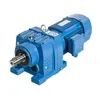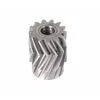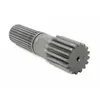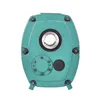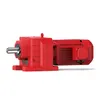A Helical Gear is a type of cylindrical gear with teeth that are cut at an angle to the face of the gear. This design allows for smoother and quieter operation compared to spur gears, making helical gears ideal for high-speed applications and heavy-load scenarios. They are commonly used in automotive transmissions, industrial machinery, and power generation systems due to their efficiency and durability.
When selecting a helical gear, it's essential to consider various technical parameters to ensure optimal performance. Below is a detailed breakdown of the critical specifications:
| Parameter | Description | Typical Range |
|---|---|---|
| Module (mm) | Indicates the size of the gear teeth; calculated as the ratio of pitch diameter to number of teeth. | 1 to 10 mm |
| Number of Teeth | Total teeth count on the gear, influencing gear ratio and torque transmission. | 10 to 100+ |
| Helix Angle (degrees) | Angle between tooth trace and gear axis; affects smoothness and load capacity. | 15° to 30° |
| Face Width (mm) | Width of the gear tooth along the axis; wider faces handle higher loads. | 10 to 200 mm |
| Pitch Diameter (mm) | Diameter of the pitch circle, critical for meshing with other gears. | 20 to 500 mm |
| Pressure Angle (degrees) | Angle between tooth profile and radial line; standard angles are 20° or 14.5°. | 14.5° or 20° |
Helical gears are versatile and used across multiple industries:
Here are some frequently asked questions about helical gears, answered in detail:
What are the advantages of helical gears over spur gears?
Helical gears offer smoother and quieter operation because the teeth engage gradually rather than all at once. This reduces vibration and noise, making them suitable for high-speed applications. They also have higher load-carrying capacity due to the angled teeth, which distribute force more evenly.
How do I choose the right helix angle for my application?
The helix angle affects the gear's performance: a larger angle (e.g., 30°) provides smoother operation and higher speed capability but may increase axial thrust. For general purposes, 15° to 20° is common. Consider factors like load, speed, and system design—consult engineering specifications or a gear manufacturer for tailored advice.
What maintenance is required for helical gears?
Regular maintenance includes lubrication to reduce friction and wear, inspection for tooth damage or misalignment, and monitoring operating conditions like temperature and noise. Use high-quality lubricants suited for the gear material and environment, and follow manufacturer guidelines for intervals (e.g., every 500-1000 hours of operation).
Can helical gears be used in perpendicular shaft arrangements?
No, helical gears are designed for parallel shaft applications. For perpendicular shafts, bevel gears or worm gears are more appropriate. Helical gears transmit motion between parallel axes efficiently but require additional components like thrust bearings to handle axial forces.
What materials are best for corrosive environments?
For corrosive conditions, stainless steel or bronze helical gears are recommended due to their resistance to rust and chemical degradation. Coatings like nickel plating can also enhance corrosion protection. Always match the material to the specific environment, such as marine or chemical processing industries.
How does the module affect gear performance?
The module determines tooth size and strength: a larger module results in larger, stronger teeth capable of handling higher loads, but may increase gear size and weight. Smaller modules allow for compact designs but reduce load capacity. Select based on application requirements, balancing strength, space constraints, and efficiency.
Are helical gears customizable?
Yes, helical gears can be customized in terms of material, dimensions, helix angle, and surface treatments to meet specific needs. Manufacturers often provide options for bespoke designs, including non-standard modules or teeth counts, to optimize performance for unique applications.
What is the typical lifespan of a helical gear?
Lifespan varies based on usage, maintenance, and material quality. Under proper conditions—adequate lubrication, moderate loads, and regular inspection—helical gears can last 10,000 to 50,000 hours or more. High-performance materials and treatments can extend life further in demanding environments.
How do I calculate the gear ratio for helical gears?
The gear ratio is determined by dividing the number of teeth on the driven gear by the number on the driving gear. For example, if a driven gear has 60 teeth and the driving gear has 20, the ratio is 3:1, meaning the driven gear rotates once for every three rotations of the driver. This ratio affects speed and torque transmission.
What are common failure modes for helical gears?
Common failures include tooth wear due to friction, pitting from surface fatigue, scoring from inadequate lubrication, and breakage from overload. Regular maintenance, proper alignment, and using gears within rated capacities can mitigate these issues. Monitoring vibration and noise can help detect problems early.
